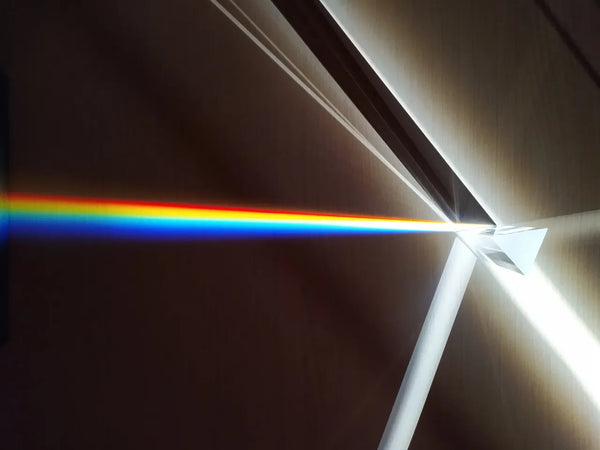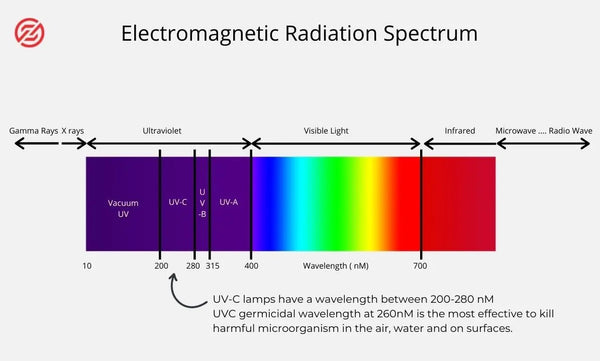It's normal to be more concerned about sanitation and disinfecting during a pandemic. But not all methods are created equal. Learn all you need to know about ultraviolet disinfection, how it works and how to use it correctly below.
What is UV light?

Image Credit: Public Domain from Wikipedia Commons
Ultraviolet (UV) light is a type of wave that is produced naturally by the sun, and artificially by using specialised bulbs and lamps. To properly comprehend UV light and how it works as a disinfectant, first we need to understand light.
Light can be difficult to grasp because it’s an intangible thing. Most of the ‘things’ around us exist as a state of matter: solid, liquid, gas or plasma. We can scoop these things up and hold them. But light is different. We can see it and feel it, but we can’t handle it in the same way as most other things.
This is because it isn’t matter, it’s a form of energy (electromagnetic energy) that exists as waves. To best understand it, think about a rock being thrown into a still body of water. The ripples move outward in waves, but the water droplets aren’t moving outward, they are just moving up and down as the waves of energy pass through the puddle. Light is like a wave in the puddle except it moves through air and space. It can carry energy and interact with matter. The types of interaction that a light wave can have on an object depends on its properties.
Waves have the same four fundamental properties of
amplitude - how tall a wave is;
speed - how fast a wave moves;
wavelength – the distance between the crests in a wave, and
frequency – a measure of how many waves pass a certain point.
Wavelength is important as it is used to classify different types of light. It is also the determiner of what light we can and cannot see. Photoreceptors are the types of cells in our eyes that process light, and human photoreceptors can only process light with wavelengths between 380 and 700 nanometres (nm). Light that falls within these wavelengths is called ‘visible light’ on the electromagnetic (or light) spectrum. Other types of light on the electromagnetic spectrum include radio waves, microwave and infrared light all with a larger wavelength than visible light. Those with a smaller wavelength are Gamma, X-ray and ultraviolet light.
Each has a different effect on different types of matter, particularly organic matter such as our skin or the cells of viruses and bacteria – this is how UV light has come to be used as a form of disinfectant.
The Discovery of UV Light

Photo by Dobromir Hristov from Pexels
The colours of the rainbow list all of the colours of light within the visible light spectrum. They are listed from red to violet in order of decreasing wavelength. Violet has the smallest wavelength and the name ‘ultraviolet’, comes from the Latin ‘ultra’, which means beyond.
In 1801, the German physicist Johann Ritter used a prism to split light into wavelengths and observe the effects that visible and non-visible waves had on chemically-treated paper. He noticed that shorter wavelengths just beyond violet darkened paper faster. What he discovered was the existence of ultraviolet light.
Types of Ultraviolet Light

Ultraviolet waves are further divided into different types of light based on their wavelengths. They are classified as UVA, UVB and UVC. You might recognise the first two wavelengths from your sunscreen.
Both UVA and UVB can damage our skin cells, particularly if we are exposed to too much of it. A ‘tan’ is our body’s defence mechanism against UV in action. Some UVB light is beneficial as it is needed to produce vitamin D that is essential to bodily functions (such as bone health and immunity), but too much can lead to cell damage.
The sun is a source of all UV light waves, but our atmosphere blocks out UVC light. UVC light has the shortest wavelength and the highest energy. These properties make UVC particularly good at penetrating viral and bacterial cells, which make it useful as a disinfectant.
Ultraviolet Germicidal Irradiation

Ultraviolet Germicidal Irradiation (UVGI) is a disinfection method that uses UVC light to disrupt the cells of organisms that can cause illness or infection. It works by penetrating the cells of organisms to disrupt and destroy the molecular bonds that form the DNA that is crucial for proper cell function. This will make the organism inert or kill it altogether.
Short wave light was first used to eradicate bacterial organisms in 1878, but it wasn’t until the 1900s that UV light was used as a disinfectant. UV light was first applied as a disinfectant in water treatment. In 1910, a prototype water treatment plant was opened (and closed shortly after due to poor results) in France. It took almost 100 years for the technique to be perfected and used widely, but now almost all large-scale water treatment plants use UV light irradiation as part of a system to purify water (other common steps include chemical and physical water filtration).
Ultraviolet germicidal irradiation technology is now widely used to disinfect hard surfaces. UVC is used to disinfect hospitals, and in light of the recent pandemic, the New York City Subway is using UVC light irradiation to sterilise subway cars daily. Technology has improved and advanced so much that at-home sterilisation equipment is now readily available to consumers.
Pens and wands (such as the Steripen) allow for users to quickly disinfect water in personal water bottles; UV light is used in appliances designed to dry and sterilise baby bottles; hand-held UVC wands can be purchased for use at home, and mini UVC lightboxes are now used to disinfect everyday germ hotspots like our mobile phones.
Does UVC work?
The efficacy of UVC light sterilisation depends on many factors such as the amount of time an organism is irradiated for; the presence of particles that can act as a physical barrier to light, and each specific organism’s ability to withstand UVC exposure. Even in a controlled environment, it is difficult to achieve 100% sanitation,100% of the time.
The most important factor for UVC light irradiation efficacy is maintaining ‘line of sight’ exposure – that is, ensuring that the design of the system doesn’t create or allow for obstacles to the surface being treated. Apart from design, dust is also another potential barrier, so it is important to remove dust on the lamp and on the surface being treated before a UVC light is used.
When treating surfaces with UVC light (as opposed to water), the effective dosage is dependent on the exposure time and the intensity of the light. Put simply, intensity is a measure of the distance between the lamp and the object in relation to the light output (in microwatts). The shorter the distance between the lamp and the object, the more intense the light is. Intensity is then multiplied by exposure time to calculate the dosage of light needed for disinfecting.
In a controlled, static environment with no moving air, the exposure time is easily reached once the correct dose is delivered. However, in environments with moving air (such as within an airconditioned or open-air area), longer exposure or higher UV intensity is needed to deliver the correct dose.
The dosage is measured in microjoules per square cm (mJ/cm2), or microwatt seconds per square cm (μW·s/cm2). Most bacteria and viruses require a dosage of between 2-15 mJ/cm2 for 99% eradication and between 4-30 mJ/cm2 for 99.9% eradication.
Disinfection is tricky because it deals with organisms, that in themselves have many variables. This is as true for chemical disinfectant sprays as it is for UVC light disinfectants. There are extra factors at play in UVC light disinfection, but good-quality systems take all of this into account when testing and designing to ensure that the product is easy to use and effective for consumers.
Does it kill COVID-19?
This is the question everyone is asking. The short answer is that there is not enough peer-reviewed studies to give us a definitive answer that can be used to successfully eradicate the virus.
We do know that UVC light has been successful in inactivating other coronaviruses, such as SARS (severe acute respiratory syndrome) and against H1N1 (Swine flu).
Several recent studies that have yet to be peer-reviewed have found that the SARS-CoV-2 virus has been stopped from replicating with varying amounts of UVC light. These studies have found that the effectiveness of UVC light depends both on the amount of UVC light exposure and the amount of the virus that is present.
It is worth noting that all of these studies are talking about killing the virus before it enters the body, not killing the disease after the virus has infected the body.
Is UVC Safe?
Too much exposure to any form of UV light is not safe for humans, but consumer products are shielded (by a bounding box or container) to limit exposure to the light.
UVC is very effective as a disinfectant because of its ability to destroy genetic material. Unfortunately, it does not discriminate between viral, bacterial or human genetic material. This is why suggestions to use UVC light to disinfect people’s clothing before they enter public places, or using UV light inside the human body are unsafe as it will harm the person as well as viral organisms. This is much like the dangerous suggestion that consuming disinfectant chemicals will help protect the body against viruses.
Almost all disinfectants have the potential to be harmful to humans. To use UVC sanitizers (or any other disinfecting product) effectively and safely, stick to consumer products that have been designed for home use and follow the product instructions.
How to use UVC at Home
One of the easiest ways to start using UVC light for sanitation is by using lightboxes such as a UV phone sanitiser or UV Sanitiser Home. They work as miniature tanning beds designed to sanitise mobile phones – one of the germiest objects in our homes and other high-touch household items – by shining light above and below to bathe the item in UVC light and reach all surfaces.
These lightboxes can also be used to sanitise any other item that fits inside the box without touching the edges – for example, keys, bottles, toys or bank cards. Simply place the object inside, close the box and choose the appropriate cycle for your model. Once it’s done you can be assured that your item has been treated with one of the most effective forms of disinfectants.
See the range of Zoomlite UV Sanitisers here.
Resources:
https://www.medrxiv.org/content/10.1101/2020.04.02.20051409v1.full.pdf
https://www.ncbi.nlm.nih.gov/pmc/articles/PMC7112912/
https://www.cnet.com/news/this-robot-quickly-disinfects-spaces-using-uv-c-light/
https://www.wired.com/story/heres-what-disinfectants-and-uv-light-really-do-to-your-body/
https://www.insider.com/does-uv-light-kill-germs
https://nymag.com/strategist/article/does-uv-light-kill-germs-best-sterilizer.html
https://www.bbc.com/future/article/20200327-can-you-kill-coronavirus-with-uv-light





Leave a comment